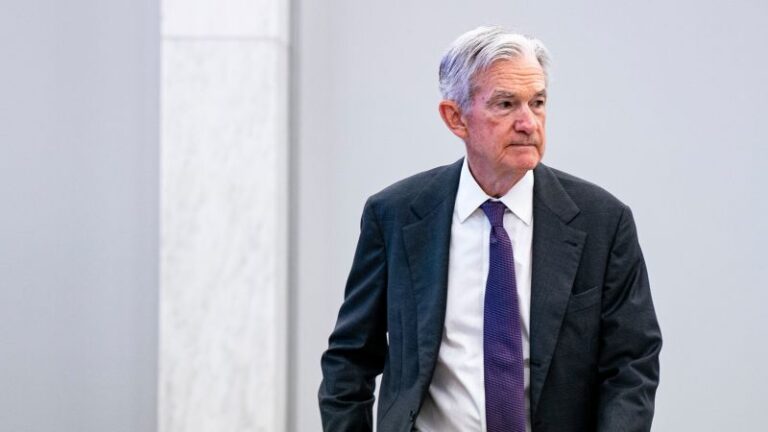Washington
—
Federal Reserve Chair Jerome Powell is set to give what could be his most consequential speech yet — just a few days after one of his colleagues was threatened with prosecution for alleged mortgage fraud.
Every year, the Fed chair gives a highly anticipated speech at an annual economic symposium hosted for the world’s central bankers by the Federal Reserve Bank of Kansas City in Jackson Hole, Wyoming. It serves to give investors a heads up on what monetary policy may look like in the months ahead.
But this year’s speech is on a radically different backdrop. For months, the Fed has been under an unprecedented full-scale assault by President Donald Trump, who has not only lobbed a series of personal insults at Powell and spoken of firing him, but who is now attempting to unseat Fed Governor Lisa Cook, who was appointed by former President Joe Biden. The president’s frustration is due to the Fed not lowering borrowing costs this year.
The speech will arguably be Powell’s last stand, with his term as chair ending in May 2026. Treasury Secretary Scott Bessent is already leading the search for Powell’s replacement and the president could announce his pick soon, several months before the end of Powell’s term. Two current Fed governors — the same ones who have broken ranks with Powell — are under consideration for chair, underscoring the rare divisiveness at the central bank.
Since December, Fed officials have kept rates unchanged, waiting to see how Trump’s widespread tariffs affect prices before resuming rate cuts, which could spur inflation.
So far, Trump’s tariffs have had a limited impact on inflation (though it remains well above the Fed’s 2% target), and Fed officials calling for rate cuts argue any increase in prices will prove temporary. At the same time, the labor market has shown growing signs of weakness.
Put together, financial markets now see a compelling argument for an interest rate cut as soon as September. But it won’t be an easy call.
“The Fed is really between a rock and a hard place right now,” said Paul Eitelman, global chief investment strategist at Russell Investments. “I don’t think Powell has enough clarity yet to strongly signal a September cut, but he will have to flag risks to full employment.”
“Ultimately, our view is that the Fed will be able to cut interest rates in September,” he added.
Most mainstream economists expect Trump’s tariffs to push up prices, although to what extent remains to be seen. But the idea that those price pressures may be short-lived has gained traction among Fed voters.
That’s what the two Trump appointees who dissented from consensus and backed a rate cut at the central bank’s July monetary policy meeting — Fed Governor Christopher Waller and Fed Vice Chair for Supervision Michelle Bowman — have argued. The ways that businesses have managed tariffs so far has played a crucial role in keeping consumer inflation at bay for now.
“Even if we’re starting to see some pressures build from the tariffs and that they could eventually be passed through, the argument is that these will still be largely temporary adjustments,” said Kathy Bostjancic, chief economist at Nationwide.
The latest data is indeed starting to show that price pressures are increasing on the wholesale level.
The July Producer Price Index, which measures the prices businesses pay their suppliers, jumped 0.9% from the prior month, boosting the annual rate to 3.3%. The monthly and annual figures both rose much more than economists had expected.
Bowman said in an interview with Bloomberg on Tuesday that she still thinks the Fed should cut rates now, despite the much-hotter-than-expected PPI figure for July.
Powell himself has frequently pointed out that it’s still not clear how persistent tariff-induced inflation will be — and it could be a while until that becomes apparent.
“The Fed is not going to have a clear answer whether it’s going to be a one-time shift or not until probably into next year,” said Garrett Melson, portfolio strategist at Natixis Investment Managers Solutions. “But they still have to be making these decisions.”
The labor market is the official theme of the Jackson Hole conference — demographics, productivity and macroeconomic policy.
The average pace of monthly job growth from May through July was weaker than any other three-month period since 2009, outside of the pandemic recession in 2020. Job gains this year have been driven by just a few industries, too; health care, social assistance and local government.
It’s also become exceptionally difficult for unemployed Americans to find a job, at least compared to prior years. In July, the number of people unemployed for more than 26 weeks reached its highest level since December 2021, at 1.85 million, though it remains well below Great Recession levels.
Not only is the Fed responsible for taming inflation, it’s also supposed to preserve the labor market’s strength. In addition to their views that tariff inflation might be only temporary, Bowman and Waller have also raised concerns about the labor market. But they’re not the only ones among Fed officials.
“The labor market has softened, and I would see additional slowing as unwelcome,” San Francisco Fed President Mary Daly wrote in a post on LinkedIn last week. “Once the labor market stumbles, it tends to fall quickly and hard.”
Fed officials have also floated the possibility that a weakening labor market is precisely what would keep tariff-induced inflation from becoming entrenched, since companies won’t have as much flexibility to raise prices with more consumers finding themselves out of work.
“If you do see pressure on both sides of the mandate, then you’re always trying to ask the question, is the labor market going to get bad enough that it’s going to do the work on inflation for you?” Richmond Fed President Tom Barkin said during an August 14 virtual discussion hosted by the National Association for Business Economics.
“High unemployment is in fact disinflationary,” he said.


